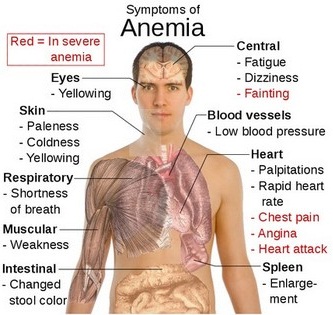
If you have anemia, your body doesn’t have enough healthy red blood cells (RBCs) to carry oxygen to your tissues. Anemia has many types and can be caused by different factors. If you constantly find yourself asking “Am I anemic?” consult your doctor to make sure you have no signs of a serious illness. But, first of all let's learn how to identify "I'm anemic or not?" There are 3 simple steps you can follow.
Step 1: Understand the General Symptoms of Anemia
Symptoms of anemia vary depending on type, cause and severity. Other underlying health problems can also influence the symptoms that persist. Additionally, anemia that is mild or develops slowly over a long period of time may not be easily noticeable because of the body’s ability to compensate for early anemia. The most common symptoms of any kind of anemia include:
- Pallor
- Insomnia
- Leg cramps
- Shortage of breath
- Difficulty concentrating
- Unusually fast heartbeat
- Headaches and dizziness
- Energy loss and excessive fatigue
Important Notes: If you notice that you exhibit any of these symptoms, contact your doctor immediately to prevent further complications:
- Pale skin
- A family history of anemia
- Excessive exposure to lead
- Unusually heavy menstrual flow
- Deficiency in vitamin and mineral intake
- Fatigue, shortness of breath, and rapid heart rate
- Ulcer, gastritis, hemorrhoids, bloody bowels, or colorectal cancer
If you are considering having a pregnancy, your doctor may ask you to take folate and other supplements before conception.
Step 2: Recognize the Type of Anemia
1. Iron Deficiency Anemia
If you have an iron deficiency, you may experience a strange, unexplainable hunger for substances such as paper, dirt or ice. The corners of your lips may be cracked, and your nails may curve upward.
2. Vitamin B12 Deficiency Anemia
If your anemia is caused by a Vitamin B12 deficiency, you may feel tingles in your hands and feet, lose your sense of touch and find difficulty moving your limbs. In extreme cases, you may experience hallucinations, dementia, paranoia and schizophrenia.
3. Chronic Lead Poisoning Anemia
If you are a victim of chronic lead poisoning, you will observe a blue-black lead line along your gums. You may also experience abdominal pain, nausea, vomiting and constipation.
4. Chronic Red Blood Cell Destruction Anemia
If chronic red blood cell destruction is what causes your anemia, you may undergo jaundice, urine discoloration, gallstones and leg ulcers.
5. Sudden Red Blood Cell Destruction Anemia
Sudden red blood cell destruction anemia also causes jaundice and urine discoloration and leads to small bruises, abdominal pain, seizures, and symptoms of kidney failure.
6. Sickle Cell Anemia
You may experience fatigue and pain in your joints, limbs, and abdomen if you have sickle cell anemia. You may also be more prone to infections. Children with this condition also experience delayed growth and development.
Step 3: Get a Diagnosis at Doctor's Office
Your doctor will perform a physical exam to check for symptoms of anemia. He will also ask about your family medical history and order some blood tests to confirm his diagnosis as well as pinpoint your underlying conditions. These blood tests may assess any of the following:
- Blood iron level and serum ferritin level to gauge your body’s iron stores.
- Levels of vitamin B12 and folate, which are essential for RBC production.
- Blood and urine tests to measure your RBC life span and rate of production.
- Complete blood count to find out the size, volume, hemoglobin content, and amount of red blood cells in your body.
- Rare causes of anemia, including RBC fragility, immune attacks on RBC’s, and enzyme, hemoglobin and clotting defects.
In very rare cases, your doctor may need to take a sample of your bone marrow to pinpoint the cause of your anemia.
How Can Anemia Be Treated?
The cause, type and severity of your anemia determine the kind of treatment your doctor will prescribe. These may range anywhere from dietary changes to medications, even to surgical procedures.
1. Diet and Supplements
Low levels of iron and other vitamins are most likely due to your poor diet or a preexisting medical condition. Your doctor may ask you to make changes in your eating habits and take more supplementary vitamins such as folic acid and vitamins C and B12.
2. Medications
Medicines that can treat your anemia include hormones for heavy menstruation and RBC production stimulation, antibiotics for infections, chelation therapy for lead poisoning, and medicine for your immune system.
3. Medical Procedures
Severe anemia may prompt your doctor to perform a blood transfusion or blood and bone marrow stem cell transplant.
4. Surgery
Surgery can stop potentially fatal bleeding, such as from stomach ulcer or colon cancer. You may also need to have your spleen removed if it starts destroying RBC’s too rapidly.